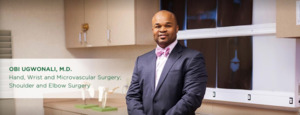As an orthopedic surgeon in a leadership role at a large, urban orthopedic practice, and as a founder of a medically-related technology company, I have had the opportunity to experience COVID-19 from both perspectives. The several weeks of down-time caused by a decreased elective surgical load, provided opportunities to reflect on some of the lessons learned from COVID-19 and how we can use those lessons to survive in a healthcare atmosphere made more difficult for physicians and others who choose to be in private practice.
Interestingly, my first opportunity for leadership and innovation came from eight years as Chair of orthopedic surgery at Northside Hospital, one of Atlanta’s major hospitals, in which there was the opportunity to start the first multi-disciplinary hip fracture treatment program for a hospital of its size in Georgia. This program led to shorter average length of stay, fewer complications, improved patient outcome and, consequently, higher hospital revenue. The overall experience provided important insight about the power of innovation applied to resolving medical problems.
A second opportunity to use innovation and business principles to help private practice directly came during five years served as medical director of Peachtree Orthopedic Surgery Center - Perimeter, one of our outpatient surgery centers, leading to development of our outpatient spine and total joint replacement center of excellence which was one of the first of its kind in the country. We were able to perform complex spine and total joint replacement surgeries in the outpatient setting in a safe cost-effective manner that helped decrease the cost of these procedures for both patients and insurance companies.
A third opportunity to use business innovation to improve patient care came through MedTrans Go (MTG), a technology company founded to decrease patient appointment cancellations. Such cancellations cost the US Healthcare Industry at least $150 billion annually. MTG was established because of experiencing first-hand cancellations of surgeries due to unavailability of foreign language interpretation services and reliable, affordable patient transportation. At the time, there was no safe and reliable on-demand solution for our patients. The obvious opportunity to utilize personal academic, medical and leadership experiences to help build a solution of potential national impact on the US Healthcare economy was compelling. Needless to say, it has not been easy, but we built out our technology, found a product/service market fit and commenced growth at a 20% quarter over quarter rate before the COVID-19 pandemic started in March of 2020.
As did nearly every business in the US, MTG and PO experienced significant decreases in volume and revenue. However, both were able to quickly rebound while other similar companies struggled, confirming to us that the investments in innovation prior to the pandemic helped both companies. PO had already invested in telemedicine and an urgent care orthopedic surgery service, both of which allowed PO to immediately commence virtual patient appointments, coupled with our in-house capacity to physically treat acute orthopedic injuries for patients afraid of hospital settings because of COVID-19. MTG was able to re-establish its trajectory by expediting the development of its medication and medical equipment delivery service and telemedicine software which enhanced its transportation and interpretation services, respectively. PO and MTG’s common attributes which allowed them to adjust to the challenges presented by COVID-19 were their previous vision and investment in technology, coupled with agility and courage to make strategic decisions in an adverse setting.
Private practice and entrepreneurship are not for everyone. You must aspire to take control of your own destiny while also being flexible in the face of an ever-changing business environment and its concomitant unknowns. The ability to not only survive but thrive depends on the willingness to imagine the future and act on what is likely to come, despite a lack of consensus among decision-makers.
One clear lesson learned from COVID-19 is that telemedicine is a useful and powerful tool. It can allow us to touch and positively impact the lives of patients across the globe and also improve the lives and outcomes of patients in our immediate geographic areas of practice. My practice utilized telemedicine to reduce overhead. Because we experienced a significant decrease in surgical volume, my partners and I were able to schedule telemedicine visits on our surgical days, thereby avoiding the need to physically open up clinic with the associated overhead (front desk, clinical assistants, and x-ray techs). Without this ability to treat patients virtually, we would have had a more dramatic decrease in revenue and not have the ability to decrease cost. Telemedicine also allowed us to maintain our patient satisfaction rate because we were able to continue to communicate with and give excellent care to our patients who were at an increased risk of complication if exposed to COVID-19. We continue to receive gestures of appreciation from patients unable to be seen in person because of COVID-19, or a personal or professional obligation that prevents them from physically coming to our office.
Telemedicine is just one of the technological solutions proven extremely useful during this pandemic and likely into the future. The overwhelming results and responses we’ve witnessed lead me to realize that a significant portion of our practice can be dedicated to telemedicine performed at a workplace, home office or basement without the need for expensive clinic space, leading to a tremendous reduction in overhead in both real estate and full-time equivalent (FTE) costs. Despite the reluctance of insurance companies to maintain reimbursement for telemedicine, it can remain a viable option after the pandemic because of the benefits to the physician and patient. The economics could be beneficial to all involved in the settings of workman’s compensation, independent medical evaluations, second opinions, and self-pay. This is just one example of the power of technology and innovation. It is up to individual practitioners to investigate how some of the emerging technologies and innovations might enhance their own practices in this new era.


